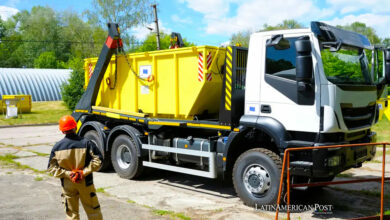This is how the Saharan dust cloud affects Latin America
Listen this article
We tell you about this phenomenon that intrigues scientists because of its relationship with climate change. Find out here its effects

Commonly known as the Sub Saharan Cloud or Saharan Air Layer, it is one of the most recent phenomena associated with climate change that worries researchers because of its considerable impact on the ecosystems of Latin America. Since the mid-90s, an interdisciplinary scientific team of NASA is observing -through satellite equipment, during the months of May, June and July, the three warmest of the African region- how huge masses of desert dust are dragged by the trade winds crossing the Atlantic and arriving to South America.
Leer en español: Así afecta la nube de polvo sahariana a América Latina
The phenomenon has occurred annually since the mid-1920s, at which time the desertification margin of the aforementioned area has doubled by 10% of its original size. Other recent researches such as those conducted by the University of Maryland also study the erosion caused by global warming, which has made it possible for dust particles to reach proportions equivalent to one tenth of human hair. NASA has also calculated that the volume of displaced land can reach a total mass of 182 million tons per year.
Brazil: impact of African dust on the Amazon rainforest
Through exhaustive analysis of dust samples taken from the Amazon river basin, it is known that the dust cloud is responsible for a high volume of the presence of compounds such as phosphorus, sulfur and nitrogen in these territories, favoring to a great extent their characteristic fertility . It is estimated that of the total of 182 million tons of dust transported, only 27.2 of them are deposited annually on the Amazon basin, specifically on the western regions of lush Brazil.
Hongbin Yu, a respected scientist who is a member of NASA through the University of Maryland, recently blamed an old South African depression in Chad, specifically in the Bodele region, for the high concentrations of phosphorus present in the South African transoceanic dust. Through the use of satellite images, sufficient evidence was found to solidify the theory that this region was once the bed of an ancient lake that served as a primitive storehouse for that element.
Read also: Be aware: El Niño will arrive soon
Another of the most important researchers of this phenomenon has been the Argentine geophysicist Santiago Gassó, who stressed that the fertilization phenomenon is vital for the maintenance of the "lung of the planet", and therefore its production of total oxygen. Gassó also highlighted the importance that this phenomenon entailed for the entire ecosystem of the South American Atlantic margin, being able to release nutrients for the maintenance of the life of phytoplankton and other marine biomes.
Puerto Rico, Cuba and the Dominican Republic: air pollution in Central American countries
According to the National Meteorological Institute of Costa Rica (INM), the arrival of the Saharan mass during warm months may be able to raise the concentrations of particulates to a ratio of 50 to 30 micrograms per cubic meter. A polluting measure that exceeds even the statistical averages of pollution of the mega cities. The Pan American Health Organization has conducted studies on how desert dust has a high concentration of spores, germs and various bacteria that together with a high concentration of iron and mercury create a lethal pesticide effect.
The appearance of asthma, allergies, inability to breathe, and burning eyes is one of the main symptoms in the way in which the ecosystems of Latin America are affected by this process in the Central African population. In Honduras, the Permanent Commission of Contingencies (Copeco) recommends to its residents the use of elements such as masks and wet handkerchiefs for people of nursing age, in the process of advanced pregnancy, as well as for elderly individuals.
Regarding the state of health in countries such as Cuba and El Salvador, the picture turns out to be similar. In this case, pneumonia appears at the top of the list of chronic conditions in various sectors of Havana and in the different provinces. Other studies, such as those carried out by the meteorological center of the western province of Pinar del Río, establish that the cloud influences the health of numerous animals, including livestock, and the decrease in yield in rice, beans, sugarcane and other crops. sugar, and various types of fruits.
Yucatan Peninsula, Gulf of Mexico and the Caribbean Sea: lower intensity hurricanes and alteration of underwater systems
The cyclonic season of the middle Atlantic is one of the phenomena that are mostly affected by the presence of large masses of desert dust suspended over the low tropical troposphere. Other important data thrown by the Goddard Space Flight Center, analyze the degree of influence that solar reflection has on the temperature of the ocean.
When the huge landmasses do not reach the continental shelf, they are suspended over regions such as the Caribbean Sea and the Gulf of Mexico, reflecting the sun's heat back into outer space, preventing the ocean from accumulating sufficient energetic power to generate cyclonic storms and therefore hurricanes.
It may interest you: Polarizing the earth: Harvard's experiment to cool the planet
William Lau and Kyu-Myong Kim, two renowned experts of the aforementioned department, were the first to observe in mid-2006 a notable example of this. Through their analyzes they were able to demonstrate how the dust of the Sahara was able to reduce the ocean temperature from 0.37 to only 0.72 degrees Fahrenheit in less than a year, a decrease equivalent to 30 or 40% to the annual general thermal average. The African regions from which this type of dust can be released generally coincide with the geographical basin of Mauritania.
Coral reefs, on the other hand, are the first underwater systems of life that are affected, a phenomenon that occurs in parallel to the mechanisms of fertilization. Copper is a mineral that inhibits the reproduction of the gametes through which this type of organism proliferates. Coral diseases arise due to the toxic components that this phenomenon harbors, specifically caused by the influence of the fungus Aspergillus Sydowii, whose influence in the Caribbean Sea is responsible for 56% of the lethal aspergillosis or disappearance of the coral.
The "Sarahan Air Layer" and climate change
Despite its recent study, attenuation, and discovery, transcontinental clouds of dust from the Sahara are already revealing important data about the mechanics of terrestrial climate operation. As it overheats as a result of exacerbated human consumption, the troposphere has begun to unfold its most recondite mechanisms of self-regulation and cooling, with SAL being one of the most studied.
In other regions of the world, the same phenomenon is capable of forging diverse effects such as the decrease of rains, sunsets and red tides, including regions such as Spain, France, the United States and Britain.
This reality allows experts a field of scientific work large enough to place the Saharan Air Layer within the global climate work matrix, allowing them to study it as a whole mechanism of preventive self-regulation of global atmospheric health.
The impact of this type of components on agriculture worldwide is enough to relieve its importance: only the Amazon rainforest produces 20% of the planet's oxygen, enough to shovel the harmful effects of the desertification of the Sahara itself while the rest of the silicates compounds cool the rest of the continents.
Read also: This is how our diet affects environment
For the future, many of the South American countries that are currently expected to be mostly populated could experience a better control of adequacy considering the permanence of this type of phenomena, the control of their harmful effects and, of course, helping nature itself through of reducing the impact that human society may have on the ecosystems of Latin America.
LatinAmerican Post | Abraham Nuñez
Translated from "Así afecta la nube de polvo sahariana a América Latina"





